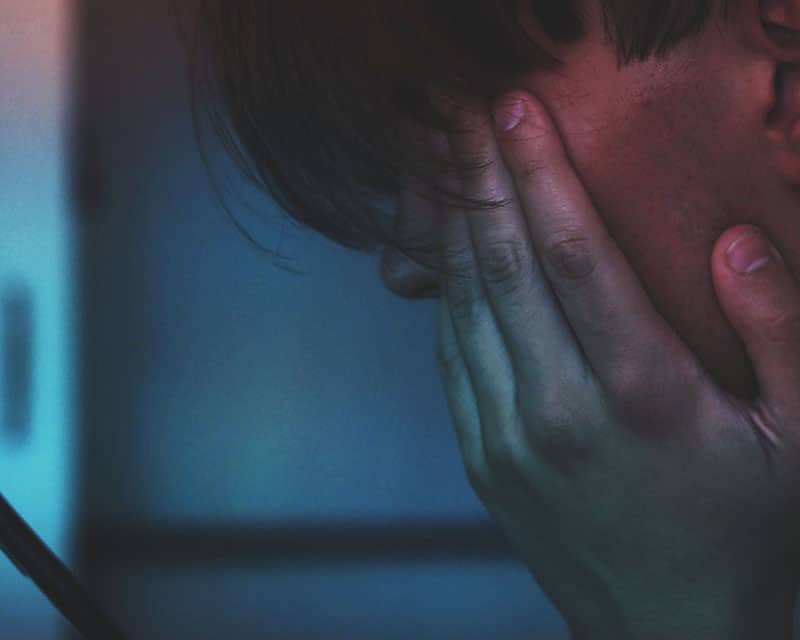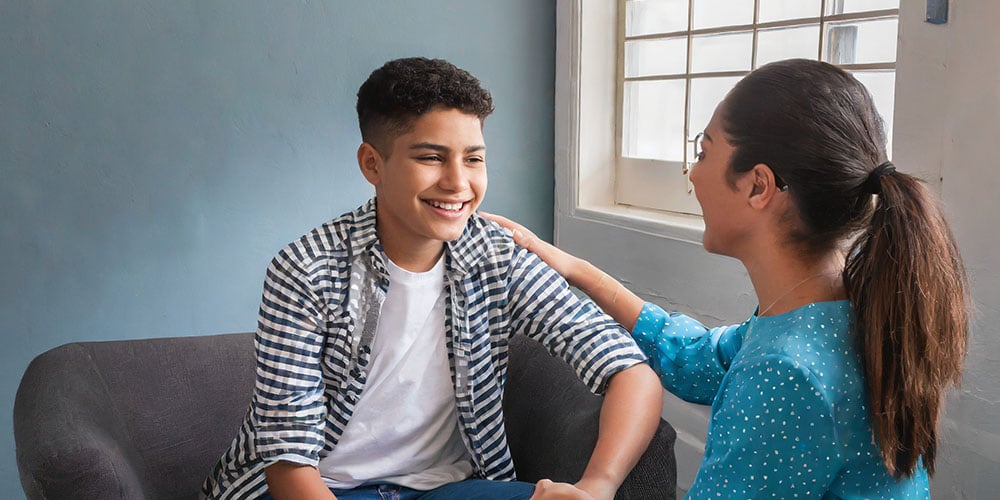
Are you concerned about teen porn addiction and its impact? You're not alone. Many families today are facing the challenges of teen pornography addiction. It can feel overwhelming, leaving you unsure of where to turn. Here at Oxbow Academy, we understand the emotional toll this takes on both teens and parents. Our specialized program offers a safe and supportive environment where teens can heal and rebuild healthy behaviors. We believe in empowered futures, and our approach focuses not only on overcoming addiction but also on fostering strong family bonds and creating a path toward a brighter tomorrow. Let us help guide your family on this journey of healing and hope.

- Teen porn addiction is characterized by a compulsion to consume pornography, leading to adverse effects on mental and physical health, with 11% of men and 3% of women reporting addiction.
- Factors contributing to teen porn addiction include dopamine release during consumption, underlying mental health conditions, family dynamics, and the easy accessibility of porn on the internet.
- Effective approaches to combating teen porn addiction include open communication about pornography’s impact, setting clear internet usage boundaries, and seeking professional help for therapeutic interventions.
If you’d like to learn more about porn addiction in teens. This article is meant to be as extensive as possible and will probably include sections that may not interest you. Please use the table of contents to find the information you need.
At Oxbow Academy, we understand the profound impact teen porn addiction has on individuals and families. Our comprehensive program offers a path to healing and a brighter future. Here are the top 3 benefits your teen and your family will gain by enrolling at Oxbow Academy:
- Empowered Teens: Our program equips teens with the tools and strategies they need to manage urges, build resilience, and develop healthy coping mechanisms. This empowers them to overcome addiction and reclaim control of their lives.
- Stronger Family Bonds: Porn addiction can strain family relationships. Our program incorporates family therapy and support groups, fostering open communication, rebuilding trust, and creating a supportive network for healing.
- Lasting Recovery: We go beyond simply stopping the behavior. Our therapists address the underlying causes of addiction, leading to long-term change and a foundation for a healthy, fulfilling future for both teens and families.
We understand the emotional toll a pornography addiction can take on your family. We're here to support you every step of the way. Oxbow Academy offers a safe and effective path to recovery. Call us today for a free consultation and let's discuss your teen's unique needs. Or keep reading to learn how we can help your son. This article will explore what teen porn addiction is, how to recognize it, and effective steps to tackle the challenge.

Your teen can recover from sexual behavioral problems. Contact one of our trained representatives for a free, private consultation
What is Pornography Addiction?
There are multiple levels of pornography usage. Having a pornography habit and a pornography addiction is not the same thing; people can use pornography casually without becoming addicted. However, some pornography users engage in a level of compulsive viewing that can be considered an addiction.
The American Psychiatric Association created The Diagnostic and Statistical Manual of Mental Disorders (DSM-5). This manual is used to diagnose mental health issues. Pornography addiction is not an official diagnosis but can be classified as a process or behavioral addiction. Because the DSM-5 does not recognize the existence of sex addiction, porn addiction, or Problematic Pornography Usage (PPU), there is an ongoing debate about how to define or even acknowledge these issues.
The DSM categorizes disorders based on how much they disrupt daily life. Pornography addiction is when someone compulsively views pornography despite the negative effects it has on their life. What distinguishes this addiction from a simple interest in porn is the negative consequences that result from the behavior. Teenagers with a porn addiction spend excessive amounts of time viewing porn instead of engaging with others or accomplishing important tasks, even when it harms their school, work, relationships, or personal well-being.
Pornography Addiction Statistics
Pornography has undergone a significant transformation since the 1950s. Gone are the days of just a Playboy magazine or a plot leading to sexual encounters. Today, it is much more explicit, straight to the point, and continually pushing boundaries. If it can be imagined, it can be found.
While Playboy's initial issue, published in 1953, sold 54,000 copies, nowadays, people access porn through online videos, pictures, and apps. Websites like Pornhub are dedicated to providing explicit content, and in 2019 alone, it had 42 billion visitors, averaging 115 million per day, 5 million per hour, and almost 80,000 per minute. In comparison, more users visit Pornhub in one minute than the number of Playboy's first edition sold in 1953.
The statistics on pornography addiction are alarming. Here are some key facts:
- More users visit Pornhub in one minute than the number of Playboy's first edition sold in all of 1953.
- 20% of all Internet pornography involves children, with more than 20,000 new images posted weekly.
- The largest group of online porn consumers is children ages 12-17.
- 15% of teen respondents said they first saw online pornography at age 10 or younger.
- In a 2016 Middlesex University study of 11- to 16-year-olds, more than half of the boys (53 percent) thought internet pornography is a realistic depiction of sex.
- Of 9–19-year-olds, 57% came into contact with pornography online, and less than a quarter of those intentionally searched for porn.
- 93% of boys and 62% of girls were exposed to internet pornography during their teenage years.
- Many children are first exposed to pornography during adolescence between the ages of 9 and 13. This is the average age when they are first exposed, which means that there is a smaller percentage of kids between the ages of 4-8 exposed to pornography as well.
- 75% of 7 to 11-year-old boys and 67% of 7 to 11-year-old girls in treatment for PSB reported early sexualization through online pornography.
- Research from a 2019 study shows that content mostly gets viewed on computers (reported by 73% of participants) and phones (62% of participants).
These figures paint a stark picture of the pervasiveness of pornography in the lives of teenagers. With close to 100% of 15-year-old males and 80% of 15-year-old teenage girls reporting exposure to violent and degrading online pornography, it’s clear that early sexualization due to porn is a pressing concern for young people.
Porn Addiction Signs & Symptoms
Teenagers struggling with pornography addiction may exhibit a variety of signs and symptoms. Here are some key areas to watch for:
Behavioral Changes:
- Increased Secretiveness: Spending excessive time online, hiding browsing history, being withdrawn or secretive about phone or computer use.
- Changes in Habits: Loss of interest in hobbies, neglecting schoolwork, changes in sleep patterns (staying up late to watch pornography).
- Social Withdrawal: Isolating from friends and family, avoiding social interaction.
Risky Behavior: Engaging in sexual activity beyond their developmental stage, and visiting inappropriate websites. - Inability to abstain from watching porn even when it negatively affects their personal life.
Emotional Changes:
- Mood Swings: Irritability, frustration, anxiety, anger, outbursts, or depression when unable to access pornography.
- Shame or Guilt: Feelings of shame or guilt after watching pornography.
- Low Self-Esteem: Negative body image, decreased self-confidence.
Physical Changes:
- Increased Fatigue: Tiredness due to late-night pornography use or excessive masturbation.
- Changes in Appearance: Neglecting personal hygiene due to preoccupation with pornography.
It's important to remember that these signs can also be indicative of other issues teens may be facing. If you notice a combination of these symptoms, it's crucial to talk to your teen or seek professional guidance to understand the root cause and determine the most appropriate course of action.
Why is Pornography Addictive?
For teenagers, the allure of pornography can be even more potent due to their developing brains and the heightened novelty associated with sexual content. Beyond the emotional and behavioral changes, teen pornography addiction can also have a significant impact on the developing brain.

What Does Porn Do to Your Brain?
The addictive nature of pornography stems from the powerful release of feel-good chemicals in the brain, akin to the reaction triggered by drugs or alcohol. This release creates a cycle of craving and reward that can be difficult to break.
Porn and Dopamine
Dopamine is the brain's reward chemical. It makes us feel good as a reward for doing things that will help us survive and succeed in life. For example, we feel dopamine when we laugh, exercise, eat, or have sex. Dopamine plays a crucial role in habit formation in teens, and understanding this connection can be helpful when addressing teen porn addiction. Here's how dopamine works in this context:
- Reward Pathway: When a teenager engages in a pleasurable activity, like watching pornographic materials, the brain releases dopamine. This dopamine surge creates a feeling of reward and reinforcement.
- Positive Reinforcement Loop: The pleasurable feeling associated with the dopamine release motivates the teenager to repeat the behavior (watching pornography) in the hope of experiencing that reward again.
- Habituation: Over time, with repeated engagement, the brain may need more and more stimulation (pornography) to produce the same level of dopamine release. This can lead to increased intensity or frequency of porn use to achieve the desired feeling.
- Dopamine and Development: The teenage brain is still under development, and the reward system is particularly sensitive. This makes teenagers more susceptible to forming habits, both positive and negative, like porn addiction.
In essence, dopamine creates a feedback loop that reinforces the behavior of watching pornography, potentially leading to addiction.
Porn and Oxytocin
Oxytocin, or the "cuddle hormone," is another hormone that is released when your child views pornography. This chemical in the brain helps with attachment in relationships. Here's how oxytocin contributes to the problem:
- Bonding and Attachment: Oxytocin is often referred to as the "bonding hormone" because it promotes feelings of trust, connection, and social interaction. For teenagers wanting attachment or a relationship, pornography becomes the path of least resistance to create a counterfeit attachment and feel connected. It is easier for someone seeking acceptance to click a button than to reach out to another person the same age and try to talk to them while navigating the complexities of social cues, and complex relationships. Plus, they don't have to worry about the fear of being rejected by pornography either. Pornography fills the void of loneliness and helps them to feel a false sense of connection and attachment.
- Pornography and Fake Intimacy: While pornography can create a temporary sense of arousal and release oxytocin, it's a simulated intimacy that lacks the emotional connection and real-life interaction necessary for healthy oxytocin release.
- Distorted Expectations: Repeated exposure to pornography can create unrealistic expectations of intimacy and relationships. This can hinder a teen's ability to form healthy, oxytocin-driven bonds with real partners.
- Reduced Empathy: Some studies suggest a link between excessive pornography use and decreased empathy. Oxytocin is also associated with empathy, so this decrease could be related to the lack of genuine connection in pornography use.
In summary, oxytocin plays a complex role in teen pornography addiction. It can initially be triggered by the simulated intimacy of pornography, but over time, it can contribute to difficulties forming healthy relationships and experiencing genuine emotional connection.
What Causes Porn Addiction in Teens?
There are many reason why teens seek out or view porn, including:
- Biological need
- Curiosity
- Loneliness: Seeking Attachment & Connection
- Social or Peer Pressure
- Stress
- Seeking a dopamine fix
- Exposed at an early age
- They have been sexually abused

Experts say that pornography addiction can arise as a negative coping mechanism when teens seek to escape adverse BLAST emotions:
- Bored
- Lonely
- Angry
- Stressed/Sad
- Tired
Teen porn addiction, however, is the result of a complex interplay of many factors. Some of the factors that contribute to pornography addiction include:
- Underlying mental health conditions
- The shame cycle
- Family dynamics
- The sheer accessibility of pornographic content on the internet leading to early exposure and early sexualization of teens
Understanding these factors can help in addressing and preventing teen porn addiction.
Underlying Mental Health Conditions
Underlying mental health conditions can create vulnerabilities that make kids more susceptible to developing teen pornography addiction. Here's how some conditions might contribute:
- Attention Deficit Hyperactivity Disorder (ADHD):
- Difficulty with focus and self-regulation can lead teens with ADHD to seek out the intense stimulation pornography offers.
- Impulsivity associated with ADHD can make it harder to resist urges to access pornography.
- Autism Spectrum Disorder (ASD):
- Social challenges faced by teens with ASD can make pornography seem like an easier way to explore sexuality and intimacy.
- Difficulty with social cues and boundaries might lead them to misinterpret the portrayals in pornography.
- Obsessive-Compulsive Disorder (OCD):
- Teens with OCD might develop compulsive behaviors around pornography use, getting stuck in repetitive cycles of viewing.
- Anxiety associated with OCD could be temporarily relieved by pornography use, creating a negative reinforcement loop.
- Bipolar Disorder:
- During manic episodes, teens with bipolar disorder might experience increased impulsivity and risk-taking behavior, making them more likely to engage in excessive pornography use.
- Depression associated with bipolar disorder could lead to seeking escape or emotional numbing through pornography.

It's important to note that having a mental health condition doesn't guarantee a teen will develop pornography addiction. However, these conditions can create vulnerabilities that make them more susceptible. Early diagnosis, treatment, and open communication about healthy sexuality can be crucial in preventing addiction.
The Shame Cycle
The shame cycle plays a significant role in fueling teen pornography addiction. Here's how it works:
- Exposure and Initial Shame: A teen might stumble upon pornography accidentally or seek it out curiously. This initial exposure can lead to feelings of shame and guilt, especially if they believe pornography is wrong or forbidden.
- Secrecy and Isolation: Due to shame, teens may keep their pornography use a secret. This isolation can worsen the problem as they lack healthy outlets for discussing sexuality or managing urges.
- Increased Use to Cope with Shame: The negative emotions associated with shame can be temporarily relieved by engaging in pornography again. This creates a negative reinforcement loop, where seeking comfort through pornography reinforces the behavior.
- Escalating Use and Deeper Shame: Over time, tolerance builds, and teens need more and more extreme content to achieve the same level of arousal or emotional escape. This escalation can lead to deeper feelings of shame and self-loathing.
- Fear of Seeking Help: 79% of teens and young adults who want to stop using pornography say they have no one in their life helping them. The shame associated with pornography addiction can prevent teens from seeking help. They may fear judgment, punishment, or disappointment from parents or professionals.
This cycle traps teens in a loop of secrecy, shame, and compulsive behavior. Breaking the cycle requires open communication, building trust, and addressing the underlying shame with support and understanding. At Oxbow Academy, our therapists help teenagers develop healthier coping skills, provide education on healthy sexuality and consent, and empower them to improve their self-esteem. These tools can help them break free from their shame cycle and the negative patterns they may be experiencing. Our ultimate goal is to support teens on their journey towards a more positive and fulfilling life.
Family Dynamics
Family dynamics can play a complex and multifaceted role in the development of teen pornography addiction. Here's how some family factors might contribute:
- Lack of Communication: If teens feel uncomfortable talking to their parents about sex and sexuality, they might turn to pornography for information, leading to distorted views.
- Unhealthy Parental Attitudes: Parents with overly strict or shaming attitudes towards sex and pornography can create a sense of secrecy and shame, making teens more likely to explore pornography in isolation.
- Parental Absence or Inattention: Teens who feel a lack of emotional connection or supervision at home might be more vulnerable to seeking stimulation and validation through pornography.
- Early Exposure to Pornography: Accidental exposure to pornography can happen at home, through parents' or siblings' viewing habits, through peer pressure from friends', or through unsecured or unfiltered devices. This early exposure can spark curiosity and lead to early sexualization and compulsive use. Notably, the biochemical thrill that arises from viewing pornography is a natural consequence of exposure, with adolescents desiring to experience it again, wiring the brain early to be susceptible to the habit.
- Family Conflict: Stressful family environments or high levels of conflict can make teens more likely to seek an escape through pornography use.
- Family History of Sexual Abuse: If anyone in your family, particularly your teenager, has been the victim of sexual abuse, it may contribute to your teen's chances of developing a porn addiction.
It's important to remember that these factors are not necessarily the cause of addiction, but they can contribute to a vulnerable environment. Open and honest communication about sex, creating a safe space for questions, and fostering a supportive and connected family environment can be powerful tools in preventing teen pornography addiction.
The Accessibility Problem
The widespread availability of pornography online has undoubtedly contributed to the rise of teen pornography addiction in several ways:
- Ease of Access: Gone are the days of needing magazines or hidden channels. Pornographic materials are now just a few clicks away on any internet-connected device. This removes barriers and makes it easier for teens to stumble upon or actively seek out explicit content.
- Exposure at a Younger Age: The earlier young people are exposed to pornography, the more likely they are to develop problematic habits. The ease of access increases the chances of accidental exposure or early exploration out of curiosity.
- Desensitization and Escalation: The vast amount of readily available pornography can lead to desensitization. Teens might seek out increasingly explicit content to achieve arousal, potentially warping their understanding of healthy sexuality.
- Anonymity and Secrecy: The anonymity of the internet allows kids to access pornography without fear of detection. This perceived anonymity fosters secrecy and compulsive behavior as they feel less accountable for their viewing habits.
- Normalization Through Media: Pornography can be portrayed casually in some media, potentially leading teens to believe it's a normal or healthy part of every relationship. This normalizes unrealistic portrayals and can distort their understanding of intimacy.
Increased access isn't the sole cause of porn addiction in teens, but it's a significant contributing factor. Parents can play a crucial role by having open conversations about online safety, setting clear boundaries on device use, and fostering trust so their teens feel comfortable seeking help if they encounter pornography or struggle with addiction.
The Effects of Porn Addiction on Adolescent Development
Regular exposure to porn can disrupt the brain’s reward system and may lead to risky behaviors, including risky sexual behaviors, and accelerate sexual initiation, potentially resulting in negative outcomes later in life. Here's a breakdown of how pornography affects teens:

Brain Development:
- Dopamine and Reward System: Repeated exposure to pornography disrupts the dopamine reward system in the developing brain. This can lead to a constant craving for the intense stimulation provided by pornography, making it difficult to find pleasure in other activities.
- Desensitization: Over time, teens may become desensitized to normal sexual behavior, potentially leading to unrealistic expectations in relationships.
- Cognitive Development: Pornography use can hinder the development of healthy decision-making skills and impulse control.
Emotional and Social Development:
- Shame and Guilt: The secrecy and negative portrayal of sex in pornography can lead to feelings of shame and guilt, affecting self-esteem and social interactions.
- Difficulty with Relationships: Pornography can distort healthy relationship dynamics. Teens may struggle with intimacy and forming healthy connections based on unrealistic expectations. This can lead to pressuring partners into inappropriate sexual acts or engaging in emotionally unhealthy relationships.
- Isolation and Depression: The cycle of secrecy and shame can lead to social isolation and contribute to feelings of depression and loneliness.
Behavioral Development:
- Increased Risk-Taking: The explicit nature of pornography can encourage risky sexual behavior beyond a teen's emotional and developmental stage.
- Academic Performance: Compulsive pornography use can lead to a decline in academic performance due to lack of focus and decreased motivation.
- Aggression and Coercion: Some pornography depicts violence or coercion. Teens exposed to this type of content may be more likely to engage in aggressive or coercive sexual behavior.
- Blurred Lines of Consent: Pornography often doesn't depict healthy communication around consent. Teens struggling with addiction may struggle to understand and respect boundaries, increasing the risk of inappropriate and non-consensual sexual behavior.
Physical Development:
- Sleep Disturbances: Late-night pornography use can disrupt sleep patterns, impacting overall health and well-being.
- Neglect of Personal Hygiene: Obsessive pornography use can lead to neglecting personal hygiene and self-care.
- Increased Risk of STIs: Pornography often doesn't depict safe sex practices, potentially increasing the risk of sexually transmitted infections (STIs).
It's important to remember that these are potential effects, and the severity can vary depending on the individual and the extent of the addiction. However, the potential consequences highlight the importance of addressing teen pornography addiction and seeking professional help when necessary.
Is Porn Bad for Teens? Understanding the Effects of Early Sexualization on Teens
The early exposure to pornography and the resulting sexualization can have profound effects on teens. It can violate their evolving beliefs about their bodies, sexual development, and intimate relationships, akin to the impacts of direct sexual abuse. A teen's addiction to pornography can alter their brain's neuropathways and lead to distorted beliefs about sexual intimacy. This can then escalate to more problematic sexual behaviors and addiction.
Help My Son Is Addicted To Porn: How To Help Someone With a Porn Addiction
When confronting the reality that your son may be addicted to porn, it’s essential to maintain open communication and engage in frank discussions about the reality of porn versus real life. Setting boundaries around internet usage is also crucial to manage and support your child through their addiction.
Vigilance in monitoring online activities and proactiveness in seeking help can provide your teen with a new lease on life, free from the shackles of pornography addiction, by fostering self-control.

How to Talk to Teens About Porn
Initiating a conversation with your teen about pornography requires an open, non-judgmental approach that is tailored to their developmental stage. Here are some key points to consider:
- Avoid language that may induce shame, as it can lead to harmful outcomes.
- Emphasize the distinction between porn and real-life sex.
- Teach about consent and the importance of respecting boundaries.
- Address any evidence of addiction seriously and seek professional help if needed.
- Focus on being part of a support team with your teen against their pornography usage problem, rather than focusing on them as the problem.
Having a constructive dialogue that covers these points can help combat porn addiction and promote healthy attitudes towards sexuality.
Setting Boundaries and Expectations
Making sure that you create healthy boundaries around electronics and smartphones is an essential step with your teen. Various things you could consider doing are:
- Determine an appropriate age to give your child a smartphone. There are other phone type options besides a typical smartphone that you could give them if they are younger such as a flip phone, a smart watch or a safe smartphone for kids like a Gabb Phone. Just because their friends may have a smartphone may not mean they are ready for one or need one. Experts recommend not letting your teen have a smartphone until they are 14 years old or older.
- Seek out parental controls to place on your electronics and smartphone. There are many options out there separate from the electronic or smartphone setting options that can help monitor what your teen is doing on their electronics. And limit them from accessing pornography.
- Educate yourself about various social media apps, and what your child can developmentally manage at their age. Many children don't understand the dangers that can come with social media that not only involve pornography, yet other risks. In that case, not allowing social media apps until they are more mature to handle them may be the right direction. Some experts recommend not letting your child sign up for social media platforms until they are 16+.
- Set time limits on when they can access their electronics. Make it a privilege, not an entitlement to use electronics. For example, they can not use their electronics until after their homework and chores are done. Then they are only allowed an allotted amount of time on the electronics.
- Set boundaries around electronics and bedtime. Have a designated place where their smartphones or electronics are stored at night and don't allow them to take them to their room for bedtime.
- Require that smartphones and electronics be used in a public place in the house. Do not allow them to be used behind closed doors.
- Educate yourself on various electronics. Be aware that technology advances fast, and if they have access to wifi on their electronics, they can usually access pornography (even on a Kindle or Xbox).
- You are the parent. Ultimately you set the rules around their electronics and smartphone. If you feel their behavior is being greatly affected by their electronics, you can take their electronics away, until they can correct their behavior and follow the rules around it.
Putting boundaries in place may help your teen limit their access to pornography, slow down their search for it, and hopefully allow them to decide not to seek it out. Yet there are no parental controls or boundaries that you can set in place to adequately limit your teen from accessing pornography, especially if they want to seek it out. There are ways around parental controls and ways to erase their history as well or go incognito on a webpage so their account is not tracked. You also cannot control what they have access to at a friend's house.
Ultimately, the most important thing you can do is create open communication and a safe environment where your teen can feel comfortable coming to talk to you about their pornography use. If your teen seems to become possessive over their electronics or smartphone or become increasingly upset when you set limits around them, then it may be a red flag that there is more going on and that you need to seek further help.
How Do I Know If My Son Needs Help?
There are clinical evaluations that can help determine whether or not a teen’s sexual interest is healthy or potentially dangerous. One of the most respected evaluations is the Sexual Addiction Screening Test (SAST).
SAST asks a series of simple yes or no questions. The questions are designed to be answered by a parent or guardian about their teen. The answers are completely confidential.
When the SAST is complete, you will be taken to a new page that shows a score representing the level of risk. Your personal information will not be linked to the SAST score.
After you get the SAST result, you will have the chance to request a call from someone who can help answer your questions. You will only be contacted if you make a request. Whether you request a call or not, your information will remain confidential. The use of the SAST does not put you under any obligation.

When to Seek Professional Help For Teen Porn Addiction
It's understandable to be unsure whether your son's pornography use warrants professional help. Here are some key signs that indicate it's time to seek professional support:

Changes in Behavior:
- Secrecy and Isolation: Is your son spending excessive time online, hiding his browsing history, or becoming withdrawn and secretive about his phone or computer use?
- Changes in Habits: Has he lost interest in hobbies, neglected schoolwork, or experienced changes in sleep patterns (staying up late to watch pornography)?
- Social Withdrawal: Is he isolating himself from friends and family, avoiding social interaction? Does he seem withdrawn or disinterested in spending time with you?
- Risky Behavior: Has he engaged in sexual activity beyond his developmental stage or visited inappropriate websites?
Emotional Changes:
- Mood Swings: Does he experience frequent irritability, frustration, anger, anxiety, or depression, especially when unable to access pornography?
- Shame or Guilt: Does he express feelings of shame or guilt after watching pornography?
- Low Self-Esteem: Has his self-esteem decreased? Does he exhibit negative body image or a lack of confidence?
Increased Reliance on Pornography:
- Increased Frequency and Duration: Does he seem preoccupied with pornography, spending significantly more time watching it compared to when he started?
- Escalating Content Needs: Does he seek out increasingly explicit or extreme content to achieve the same level of arousal?
- Negative Impact on Daily Life: Is his pornography use causing problems at school, with relationships, or affecting his overall well-being?
Remember, these signs don't necessarily guarantee addiction, but they are red flags that warrant professional evaluation. Here are some additional points to consider:
- Impact on Your Concerns: If you are concerned about your son's pornography use – trust your instincts. Having these worries justifies seeking professional guidance.
- Difficulty Managing Behavior: If you've tried talking to your son about his pornography use and haven't seen improvement, a therapist can help him develop healthier coping mechanisms, gain deeper insight to his problematic pornography usage, and break the cycle.
- Co-occurring Mental Health Issues: If you suspect your son might have an underlying mental health condition like ADHD, anxiety, or depression, professional help can address both issues simultaneously.
Don't wait until the problem intensifies. Early intervention is crucial. If you see any combination of these signs or have any concerns, schedule a consultation with a therapist specializing in teen pornography addiction. At Oxbow Academy, we offer free consultations to discuss your son's specific situation and help you determine the best course of action.
How to Treat Pornography Addiction In Teens: Therapeutic Options and Recovery
A variety of therapeutic options are available to treat teen porn addiction, including outpatient therapy, wilderness therapy, and cognitive-behavioral therapy. These approaches can help manage the addiction and address underlying causes, with behavioral therapies often being more effective than medication.
Holistic treatments that integrate traditional therapy with alternative medicine techniques are also utilized to address the addiction comprehensively.

Porn Addiction Therapy
Outpatient therapy offers a flexible and effective treatment option for many teens struggling with pornography addiction. Here are some benefits porn addiction therapy can provide:
- Maintaining Routine: Outpatient programs allow your son to continue school, work, and extracurricular activities while receiving treatment. This fosters a sense of normalcy and routine during recovery.
- Family Involvement: Outpatient therapy can include family therapy sessions, allowing you to be actively involved in your son's healing process and learn how to support him best.
- Cost-Effective: Outpatient programs can be more affordable compared to residential treatment options.
- Accessibility: Outpatient programs often have flexible scheduling, making it easier to fit treatment into your family's busy life.
What is CSAT Therapy?
Outpatient therapy offers a flexible and effective treatment option for many teens struggling with pornography addiction. Here are some benefits porn addiction therapy can provide:
- Maintaining Routine: Outpatient programs allow your son to continue school, work, and extracurricular activities while receiving treatment. This fosters a sense of normalcy and routine during recovery.
- Family Involvement: Outpatient therapy can include family therapy sessions, allowing you to be actively involved in your son's healing process and learn how to support him best.
- Cost-Effective: Outpatient programs can be more affordable compared to residential treatment options.
- Accessibility: Outpatient programs often have flexible scheduling, making it easier to fit treatment into your family's busy life.
Finding the Right Porn Addiction Therapist for Your Son:
When considering outpatient programs, look for the following:
- CSAT Therapists: Ensure the program employs therapists with CSAT certification, guaranteeing specialized expertise in treating teen pornography addiction.
- Gender-Specific Programs: Consider the benefits of a program designed specifically for boys. These programs address issues unique to male experiences with pornography.
- Holistic Approach: Choose a program that goes beyond stopping the behavior. Look for options that address underlying emotional issues and promote healthy coping mechanisms.
- Family Therapy: Family therapy is crucial for healing the family unit. Seek a program that incorporates family sessions into the treatment plan.
- Support Groups: Support groups can provide valuable peer connection and understanding for your son. Look for programs offering these as part of the treatment.
Teen Porn Addiction Treatment Options: Outpatient vs. Residential Treatment
If you've just caught your son watching pornography, you may be like many parents and want to jump to immediate and intense interventions. However, it is important to choose the appropriate treatment level – outpatient or residential. Here's a breakdown to help guide your decision:
Outpatient Treatment:
- Ideal for: Teens with a strong support system at home, who may struggle with viewing pornography but can manage their urges with some external support. They are still attending school and maintaining some daily responsibilities.
- Benefits: Provides flexibility, allowing your son to continue living at home and attending school. Therapy sessions address the underlying issues fueling the addiction, while building coping mechanisms for managing urges.
- Considerations: Requires a high level of commitment from both your son and the family to participate actively in therapy and follow through with recommendations. May not be suitable if there are strong triggers at home or if your son struggles with significant withdrawal symptoms.
Residential Treatment:
- Ideal for: Teens with a severe addiction that disrupts daily life, school, and relationships. May also be necessary if there are co-occurring mental health issues, a lack of safe and supportive home environment, or a high risk of relapse.
- Benefits: Provides a structured, safe environment away from triggers. 24/7 supervision allows for intensive therapy, relapse prevention training, and building healthy coping mechanisms.
- Considerations: Residential treatment is a significant step and requires commitment from both your son and the family. It can be disruptive to his education and social life in the short term but provide life-long healing and hope for a better future.
Finding The Right Teen Porn Addiction Treatment Program For Your Family
As a parent navigating the challenges of teen pornography addiction, you're not alone. Here are some key points to consider when finding the right treatment program for your son and your family:
Choosing the Right Environment:
- Specialized vs. General Programs: Opt for programs specializing in teen pornography addiction. These programs understand the unique challenges teens face and provide tailored treatment approaches.
- Gender-Specific Programs: Consider the benefits of a program designed specifically for boys. These programs address issues related to peer pressure, social expectations, and healthy masculinity.
- Therapeutic Approach: Explore programs offering evidence-based therapies like Cognitive Behavioral Therapy (CBT) proven to address underlying thought patterns and behaviors.
- Researched based: The program uses research to track the progress of their students, and can take an unbiased approach to better understand where the student is really at in their therapeutic process.
Matching Program Features to Your Son's Needs:
- Individualized Treatment Plans: Look for programs that create personalized plans addressing your son's specific needs and level of addiction.
- Family Therapy: Choose a program that incorporates family therapy, fostering communication, rebuilding trust, and creating a supportive network for healing.
- Holistic Approach: Consider programs that address the emotional, psychological, and social aspects of addiction, potentially including elements like mindfulness or healthy coping mechanisms.
Finding the Right Fit for Your Family:
- Accreditation and Qualifications: Look for programs with accreditation and therapists with relevant experience and credentials in treating teen pornography addiction.
- Cost and Insurance Coverage: Explore insurance coverage options and financing plans to ensure affordability.
Beyond the initial search:
- Contact Multiple Programs: Don't hesitate to contact several programs for consultations. Ask questions to understand their philosophy, treatment approach, and success rates.
- Open Communication with Your Son: Involve your son in discussions about treatment options. Listen to his concerns and encourage him to express his needs.
- Trust Your Gut: Choose a program that feels like the right fit for you and your family. Trust your instincts and prioritize a safe and supportive environment for your son's recovery.
Remember, seeking help is a sign of strength. Let Oxbow Academy be a resource for you on this journey. We offer a specialized program for teen boys struggling with pornography addiction, designed to empower them and rebuild your family's foundation.
Why Choose Oxbow Academy for Your Son's Recovery
Oxbow Academy is a residential treatment program for boys between the ages of 13 and 17 who struggle with problematic or compulsive sexual behaviors. Every boy who comes to Oxbow is evaluated within the first 90-days to determine their level of risk, and if they need further sex-specific residential treatment.

Here's why Oxbow Academy might be the perfect fit for your family:
- Our Focus on Boys: We understand the unique challenges boys face with pornography addiction. Our gender-specific program addresses issues of peer pressure, social expectations, and healthy masculinity, creating a safe space for your son to heal and grow.
- Tailored Treatment: We believe in personalized plans, not one-size-fits-all approaches. When your son first enters Oxbow Academy, he will come to the Evaluation Center. All boys who come to the school spend their first 90-days at the Evaluation Center, unless they are younger than age 14 where they will be placed with students ages 10-13 year olds that would be more appropriate for them while they are being evaluated. There, the boys are observed by experienced staff members. They interact with counselors who have experience in treating sex-specific issues. Our therapists will assess your son's individual needs and craft a treatment plan focused on lasting recovery.
- Family as the Foundation: Pornography addiction impacts the entire family. We incorporate family therapy into our program, fostering communication, rebuilding trust, and creating a strong support system for you and your son.
- Rebuilding Trust: Also, during the evaluation period, your son will be prepared to take a clinical polygraph. Far from being a traumatizing experience, the polygraph is designed to help your son honestly express his sexual history so that he can begin to heal. He can be freed from his past experiences so that he may have a more positive and healthy future. This clinical polygraph allows him to move forward in truth, and start rebuilding trust with his parents.
- Proven Results: We utilize evidence-based therapeutic approaches like CBT, with a track record of success in helping teens overcome addiction and develop healthy coping mechanisms. We also are a researched desginated program that uses tools and data to track student progress. This allows our team and you as a parent to evaluate your son’s progress in a more non-biased and data driven manner.
- More Than Therapy: We offer a holistic approach to healing, addressing the emotional, psychological, and social aspects of addiction. This might include mindfulness techniques or healthy activity integration.
- A Safe and Supportive Environment: Our program fosters a sense of security and trust, allowing your son to focus on healing without judgment. Our compassionate staff and therapists provides unwavering support as you navigate this journey together. Our program also provides constant supervision and transparency with security cameras, to allow continued safety for all.
- Transparent Communication: We believe in open communication with you. You'll receive regular updates and have opportunities to discuss your son's progress with our team.
A Path to a Brighter Future: Our goal isn't just stopping the behavior; it's empowering your son and rebuilding your family bond. We equip him with the tools and confidence to make healthy choices and build a fulfilling future. - We Understand: We recognize the emotional toll this takes on families. Before your loved one ever comes to Oxbow Academy, you will speak with a highly trained Admissions Counselor. The Admissions Counselor will provide you with sufficient information to help you determine if your son needs further evaluation and help at this time. Our dedicated team is here to provide guidance and support every step of the way.
Don't Wait for Change, Start Today: Schedule a free consultation to discuss your son's specific needs and explore how Oxbow Academy's personalized and specialized approach can guide him toward recovery. Let us be your partner in healing your family.
Summary
The challenge of teen porn addiction is daunting, but not insurmountable. By understanding the nature of pornography addiction, recognizing the signs, and taking proactive steps, parents can help steer their teens away from the perils of porn. Education and open dialogue, coupled with appropriate treatment options and community support, can lay the groundwork for recovery and healthier development. As we arm ourselves with knowledge and compassion, we can guide our teens toward resilience and self-control, ensuring their transition into adulthood is not marred by the shadows of addiction.

Frequently Asked Questions
Additional Resources on Teen Porn Addiction
For parents seeking additional resources on porn addiction in teens, a wealth of material is available to provide guidance for inoculating young kids and helping parents understand the consequences of technology on children. These include:
- S-anon - 12 Step program that also provides support for family & friends of sex addicts.
- 30 Days of Sex Talks for Ages 12+: Empowering Your Child with Knowledge of Sexual Intimacy
- Fourteen Talks by Age Fourteen: The Essential Conversations You Need to Have with Your Kids Before They Start High School
- Dopamine Nation: Finding Balance in the Age of Indulgence by Anne Lembke
- The Craving Mind: From Cigarettes to Smartphones to Love - Why We Get Hooked and How We Can Break Bad Habits by Judson Brewer
Your Family Can Be Whole Again
Your teen can recover from sexual behavioral problems. Contact one of our trained representatives for a free, private consultation at 855-676-4272.

